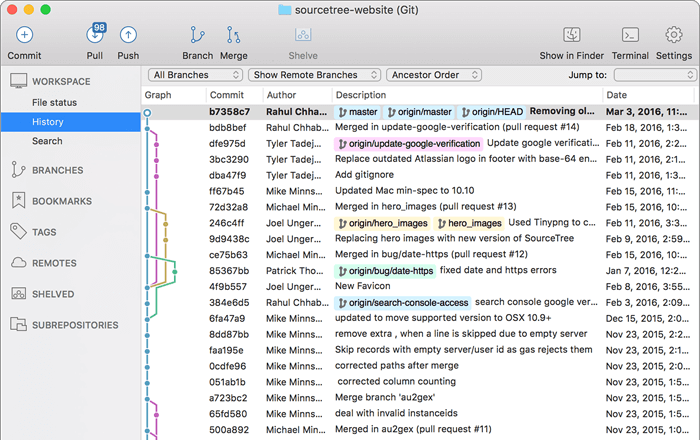Git Flow / Git Branching Model. Git flow is the set of guidelines that developers can follow when using Git. We cannot say these guidelines as rules. These are not the rules; it is a standard for an ideal project. So that a developer would easily understand the things. $ git mergetool -tool-help 'git mergetool -tool=tool' may be set to one of the following: emerge gvimdiff gvimdiff2 opendiff p4merge vimdiff vimdiff2 The following tools are valid, but not currently available: araxis bc3 codecompare deltawalker diffmerge diffuse ecmerge kdiff3 meld tkdiff tortoisemerge xxdiff Some of the tools listed above. The new Tower adds a lot of great features that help me go on with my day faster; like the ability to create pull-requests directly from the tool. Dan Counsell CEO at Realmac Tower is the perfect Git client, I honestly wouldn’t want to use anything else.
Your download is starting...
You are downloading the latest (2.29.2) 32-bit version of Git for Windows. This is the most recent maintained build. It was released 1 day ago, on 2020-12-08.
AFAIK there is no GUI that support git-flow. I develop in Eclipse but use 3rd party GUI's and CLI for git. I too use git-flow, I actually use my own fork with bug fixes and enhancements, and use it from the CLI. I use git GUI for committing, as for a while I used submodules and egit doesn't support that yet and I use gitk for checking my history.
Click here to download manually, if your download hasn't started.
Other Git for Windows downloads
Git for Windows Setup
32-bit Git for Windows Setup.
64-bit Git for Windows Setup.
Git for Windows Portable ('thumbdrive edition')
32-bit Git for Windows Portable.
64-bit Git for Windows Portable.
The current source code release is version 2.29.2. If you want the newer version, you can build it from the source code.
Now What?

Now that you have downloaded Git, it's time to start using it.
Introduction
If you look at Vincent’s original blog post, he’s listed all of the individual Git commands that you need to use to create all of the different branches in the GitFlow model. They’re all standard Git commands … and if you’re also still getting your head around Git (and still learning why it is different to centralised source control systems like Subversion, or replicated source control systems like Mercurial), it adds to what is already quite a steep learning curve.
Vincent created an extension for Git, called GitFlow, which turns most of the steps you need to do into one-line commands. At DataSift, we used it for six months, and we liked it - but we wanted it to do even more. We also wanted it to work better with GitHub, so to reduce confusion with the original GitFlow tools, we’ve decided to maintain our own fork of the GitFlow tools called HubFlow.
What Is HubFlow?
HubFlow is:
- an extension to the Git command-line tools
- a fork of the original GitFlow tools
- one-line commands for using the GitFlow branching model with GitHub
- focused on making it as easy as possible to use GitFlow with GitHub
The main differences between the original GitFlow tools and HubFlow are:
Git Flow Tool Windows 10
- by default, commands push to / pull from GitHub wherever it is appropriate
- we’ve added additional commands (such as feature push and feature pull) to fill in some gaps in the original GitFlow tools
Installing HubFlow



Installing the HubFlow tools for the first time is very easy:
Upgrading HubFlow
If you want to upgrade to the latest version of HubFlow, simply run:
Listing The Available Commands
To see all of the commands that HubFlow provides, simply run:
All of the HubFlow commands start with git hf, to distinguish them from the original GitFlow commands.
Reader Comments And Feedback
Download Git Tools For Windows
Reader Comments And Feedback
Install Git Windows
Reader Comments And Feedback
